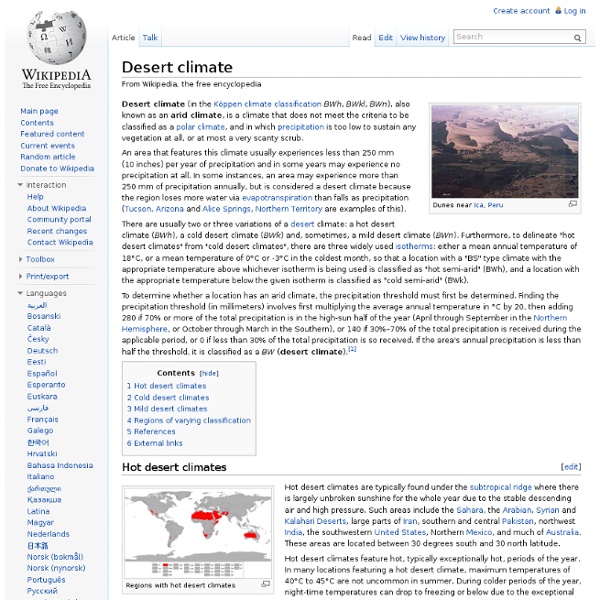Information on Desert Climates
Deserts represent one-fifth (20%) of the land surface of the world. The majority of deserts are in the Arabian Peninsula, Australia, The Americas, North and South Africa, India and Pakistan. The largest desert is the Sahara, in North Africa, and is about 3,500,000 square miles. Deserts are characterized by extreme heat and dryness, very hot in the daytime and chilly or even cold at night. The average temperature is 100 degrees during the day and below 50 degrees at night. The wettest desert does not get more than 10 inches of rain a year. A variety of plant and animal species live there, thanks to their power to adapt to the harsh environment. Animals like rattlesnakes and scorpions spend most of the day underground but come out at night to eat and hunt. Spade foot toads spend 9 months of the year underground. Deserts often get their names like "Death Valley" or "The place from where there is no return" because of their extreme conditions.
Interesting facts
It gets cold at night in the desert.
Fact1
Desert
Desert Climate Animals Plants Health Concerns The desert is dry, barren, hot, and silent. Climate There are two main types of desert in the world-the hot desert and the semi-desert. Deserts are formed when something gets in the way of rain clouds. Mountains also play a roll in forming deserts. Animals When most people think of the desert, they think of camels, snakes and lizards as being the only animals that live in the desert. Here in the Oregon desert, you can find bobcats and chipmunks and woodchucks among the sycamores. Plants Plant life in the desert is scarce, but there are more plants living here than you would expect. Plants in the desert are forced to make many adaptions in order to survive in this dry, hot land. The Desert plants are of great importance to the animals of the desert. Health concerns There are many health concerns in the desert. Snake bites are another concern in the desert. Sunburn in the desert is prevented by putting on sunscreen. Biome Index
Fact2
Fact 3
Fact 4
Facts 5
Difference Between Tundra and Desert
Tundras and deserts are both fairly large areas which see very little rain throughout most of the year. Due to this, these areas are extremely difficult to live on, and can be near uninhabitable at times. A tundra is an extremely cold area which is usually frozen over; deserts, on the other hand, are exactly the opposite, as they are excessively hot and sandy. While temperatures in tundras are shockingly low, high temperatures are a defining characteristic of deserts (particularly during the day time). Thus, while these regions share some common features (e.g. the amount of rain they get), they are completely different from one another in regards to their severe climate – in fact, they can be said to be polar opposites. Instructions 1 TundraA tundra is the region situated near the polar ice caps, with a cold, dry, windy, and icy climate.
Desert Climate
Tempting tok-tokkies | Beetles In The Bush
In the 19th and early 20th centuries, some of the America’s greatest entomologists were coleopterists. Army surgeons John L. LeConte and his protégé George W. Horn, California’s Henry C. ¹In taxonomy, a term usually cast towards those who have a combination of disregard for quality over quantity when describing new taxa and a demonstrably high ego (Evenhuis 2008). Whatever focus I do manage, it all goes out the window when I have the chance to collect in another country – especially someplace as exotic as Africa. Beetles, though – that’s a different story. Psammodes hirtipes “Tok-tokkie” refers not to a particular genus or tribe of tenebrionids, but rather a number of flightless species that have developed a unique “tapping” method of communication between males and females. Psammodes virago The online magazine Travel Africa offers an informative article about the Namib tok-tokkies and this humerous video from National Geographic: Evenhuis, N. Picker, M., C. Copyright © Ted C. Like this:
International - Scorpion Stings
Of the more than 1,000 species of scorpions worldwide, only 30 carry a toxin that may be fatal in humans. In the U.S., the rate is very low: one death from a scorpion sting occurs on average every two to three years. In Mexico, there are a reported 1,000–2,000 deaths per year. Because of their size and ability to travel in shoes and luggage, scorpions are found in many ports all over the world, having arrived as stowaways. Scorpions are nocturnal, typically emerging only at night. Being infected by scorpion venom results in a local reaction that, while painful, is easily treated with analgesics, antihistamines, ice, and supportive care. In more serious stings, pain and tingling may be followed by marked changes in blood pressure (high or low), high fever, or difficulty breathing. Treatment Elevate the injured limb at or above the heart. As to antivenom, this is available in most Mexican hospitals for more serious stings. » read more Dorothy Ngyuen - Gastric Sleeve Testimonial
Desert animals



